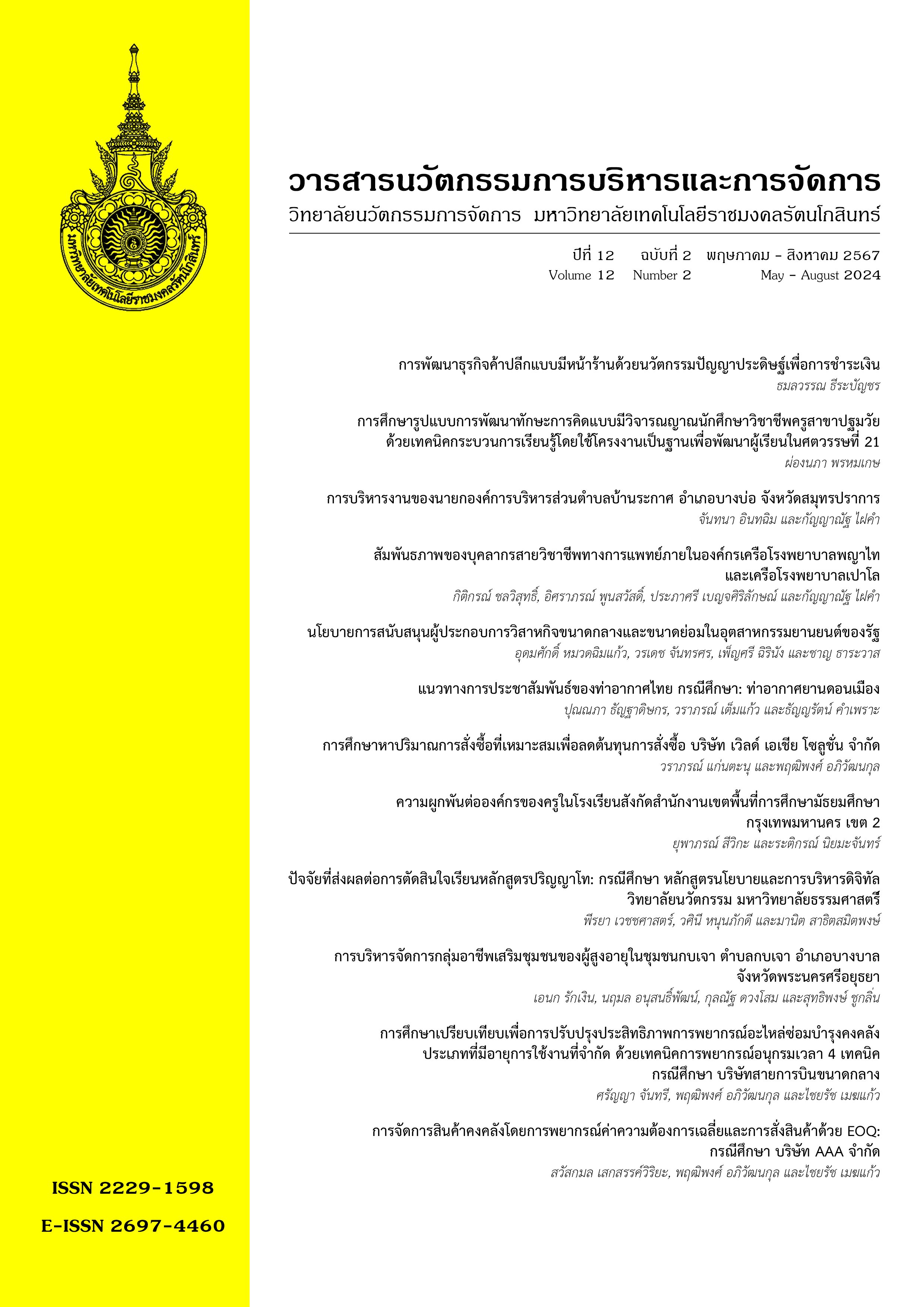การพัฒนาธุรกิจค้าปลีกแบบมีหน้าร้านด้วยนวัตกรรมปัญญาประดิษฐ์เพื่อการชำระเงิน
Main Article Content
บทคัดย่อ
บทความวิจัยนี้ เป็นส่วนหนึ่งของงานวิจัยเรื่องการประยุกต์ปัจจัยส่วนขยายในแบบจำลองการยอมรับเทคโนโลยีเพื่อศึกษาความตั้งใจใช้ปัญญาประดิษฐ์ในธุรกิจค้าปลีกแบบมีหน้าร้านมีวัตถุประสงค์เพื่อ 1.ศึกษาปัจจัยสำคัญที่ส่งผลต่อความตั้งใจใช้นวัตกรรมปัญญาประดิษฐ์เพื่อการชำระเงิน 2. ศึกษาแรงกระเพื่อมในตลาดธุรกิจค้าปลีกที่เกิดจากผลการศึกษาปัจจัยสำคัญที่ส่งผลต่อความตั้งใจใช้นวัตกรรมปัญญาประดิษฐ์ 3. นำเสนอกลยุทธ์การจัดการธุรกิจค้าปลีกแบบมีหน้าร้านในภาวะวิกฤติด้วยนวัตกรรมปัญญาประดิษฐ์เพื่อการชำระเงิน ใช้วิธีการวิจัยแบบผสมผสาน สุ่มตัวอย่างแบบโควต้าและจำเพาะเจาะจงในการวิจัยเชิงปริมาณ จำนวน 400 ตัวอย่าง และคุณภาพ จำนวน 4 ตัวอย่าง ตามลำดับ วิเคราะห์ประมวลผลด้วยสถิติเชิงอนุมานถดถอยพหุคูณ จากการวิจัยพบว่า ปัจจัยสำคัญที่ส่งผลต่อความตั้งใจใช้ปัญญาประดิษฐ์เพื่อการชำระเงิน ได้แก่ ปัจจัยความคาดหวัง
ในผลลัพธ์ของผู้บริโภค ปัจจัยคุณลักษณะของปัญญาประดิษฐ์ ปัจจัยอารมณ์ และปัจจัยการมีปฏิสัมพันธ์กับผู้บริโภค สามารถทำนายระดับความตั้งใจใช้ได้ร้อยละ 63.2 แรงกระเพื่อมที่เกิดขึ้นกับปัญญาประดิษฐ์เพื่อการชำระเงิน คือ ช่วยทำให้มีความปลอดภัยจากโควิด 19 ช่วยสร้างความเชื่อมั่นในการตัดสินใจเลือกสถานที่ใช้บริการ ช่วยเพิ่มจำนวนลูกค้าที่มาใช้บริการได้ ช่วยดึงดูดลูกค้าให้มารับบริการเนื่องจากมีขั้นตอนที่น้อย โดยกลยุทธ์สำคัญที่นำมาใช้เพื่อจัดการกับวิกฤติความซบเซาของธุรกิจค้าปลีกแบบมีหน้าร้านด้วยปัญญาประดิษฐ์เพื่อการชำระเงิน ได้แก่ ส่งเสริมการนำมาใช้งานเพื่อดึงดูดผู้บริโภคที่คำนึงถึงความปลอดภัยจากโควิด19 ในการใช้ชีวิตประจำวัน การนำมาใช้งานในร้านค้าปลีกที่มีปัญหาแถวรอคอยเนื่องจากมีขั้นตอนที่น้อย การนำมาใช้งานเพื่อดึงดูดผู้บริโภคที่ต้องการความรวดเร็วในการใช้บริการ
Article Details

อนุญาตภายใต้เงื่อนไข Creative Commons Attribution-NonCommercial-NoDerivatives 4.0 International License.
ข้อความและบทความในวารสารนวัตกรรมการบริหารและการจัดการ เป็นแนวคิดของผู้เขียน ไม่ใช่ความคิดเห็นและความรับผิดชอบของคณะผู้จัดทำ บรรณาธิการ กองบรรณาธิการ วิทยาลัยนวัตกรรมการจัดการ และมหาวิทยาลัยเทคโนโลยีราชมงคลรัตนโกสินทร์
ข้อความ ข้อมูล เนื้อหา รูปภาพ ฯลฯ ที่ได้รับการีพิมพ์ในวารสารนวัตกรรมการบริหารและการจัดการ ถือเป็นลิขสิทธิ์ของวารสารนวัตกรรมการบริหารและการจัดการ หากบุคคลใดหรือหน่วยงานใดต้องการนำทั้งหมดหรือส่วนหนึ่งส่วนใดไปเผยแพร่ต่อหรือกระทำการใดๆ จะต้องได้รับอนุญาติเป็นลายลักษณ์อักษรจากวารสารนวัตกรรมการบริหารและการจัดการก่อนเท่านั้น
เอกสารอ้างอิง
ศิริชัย พงษ์วิชัย. (2558). การวิเคราะห์ข้อมูลทางสถิติด้วยคอมพิวเตอร์ : เน้นสำหรับงานวิจัย. กรุงเทพฯ : สำนักพิมพ์แห่งจุฬาลงกรณ์มหาวิทยาลัย.
Allam et al. (2019). Applying a multi dimensioned hedonic concept of intrinsic motivation on social tagging tools: A theoretical model and empirical validation. International Journal of Information Management, 45(April 2019), 211-222.
Belsley, D. A. (1991). Conditioning diagnostics collinearity and weak data in regression. NY: Willey.
Coa, L. (2021). Artificial intelligence in retail: applications and value creation logics. International Journal of Retail Distribution Management, 49(7), 958-976.
Deloitle. (2018). Global Powers of Retailing 2018. UK: Deloitte Touche Tohmatsu Limited.
Deloitte. (2020). The future of the mall: Building the kind of destination for the post pandemic world. Canada: Deloitte.
Eleonora, P. (2012). Understanding Consumer’ s acceptance of technology – Based Innovations in Retailing. Journal of Technology Managemment and Innovation, 7(4), 1-19.
Fabius, V., Kohli, S., Timelin, B., & Veranen, S. M. (2020). How COVID-19 is changing consumer behavior-now and forever. from https://www.mckinsey.com/industries/retail/our-insights/how-covid-19-is-changing-consumer-behavior-now-and-foreve
Ghanem, B. D. (2020). Factors that Influence the Acceptance of Artificial Intelligence Technology by the Consumer (September 10, 2020). The Tenth International Conference on Engaged Management Scholarship. from https://ssrn.com/abstract=3687765
Hasan et al. (2021). A multi-method approach to examing consumer intentions to use smart retail technology. Computers in Human Behavior, 117(April 2021), 106-122.
Infosys. (2019). The Future of Shopping: How changing consumer habits are inspiring physical store transformation. India: Infosys Limited.
Myers, R. H. (1990). Classical and modern regression application (2nd edition). CA: Duxbury press.
Pillai, R., Sivatsanu, B., & Dwivedi, Y.K. (2020). Shopping intention at AI-powered automated retail stores (AIPARS). Journal of Retailing and Consumer Services, 57(3),102-127.
Pongwichai, S. (2015). Statistical data analysis by computer: Emphasizing for research. Bangkok: Chulalongkorn University Printing House.
Rodriguez, M., Paredes, F., & Yi, G. (2016). Towards Future Customer Experience: Trends and Innovation in Retail, Foresight and Sti Governance, 10(3), 18-28
Sung, H. J. & Jeon, H. M. (2020) Untact: Customer’s acceptance intention toward robot barista in coffee shop. Journal of Sustainability, 12(20), 85-98.
Statista. (2020). E-commerce share of total global retail sales from 2015 to 2021. from https://www.statista.com/statistics/534123/e-commerce-share-of-retail- sales-worldwide/
Unhelkar, B., Joshi, S., Sharma, M., Prakash, S., Ashwin Krishna Mani, A. K., & Prasad, M. (2022). Enhancing supply chain performance using RFID technology and decision support systems in the industry 4.0–A systematic literature review. International Journal of Information Management, 2(2),1-12.


